Water stain: advantages and disadvantages
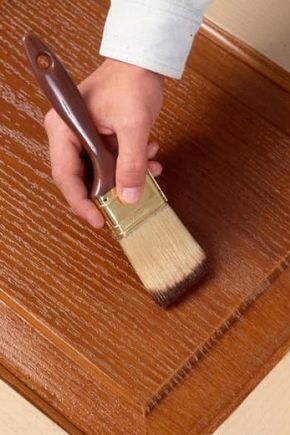
Wood stain not only performs protective functions, but also gives the wood an aesthetic appearance. With the help of such solutions, you can refresh the old wood coating or give the desired shade to a new product, without changing its natural structure. One of the types of these mixtures is a water-based stain, which has its own distinctive features. We will consider the advantages and disadvantages of this solution in more detail in this article.

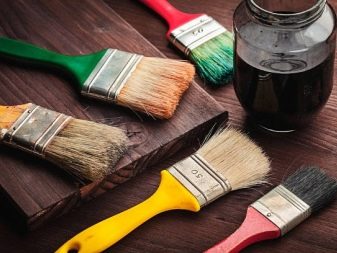
Peculiarities
Unlike paints, which create only a dense top layer of color, stains fill the very structure of the material with color, without disturbing its texture. Water-based formulations paint products in natural wood shades, which allows you to renew old wood coatings without creating the appearance of surface treatment with any dye mixture.
Water-based stains, unlike other types, are best able to emphasize the natural structure of wood. However, you need to be careful when applying a mixture to it, which has a different density in some areas of the surface.
When processing such material, stains may appear on the surface.

Aqueous formulations do not have an unpleasant odor and do not contain harmful substances. In addition, in this type of wood stain, you can change the shade - make it lighter or more saturated. To do this, it is enough to slightly dilute the solution with water. To make the shade darker and more saturated, the tinting mixture can be applied to the surface in several layers.
Water-based formulations are available as a ready-made solution or dry mix. Powdered materials must be diluted in water before application. Water-based stain is quite popular due to its low cost and ease of application. Before starting work, it is worth remembering that such a mixture dries for a rather long time.


Advantages and disadvantages
Due to its composition, water-soluble stain has a number of advantages over other types of tinting mixtures.
Let's highlight the main advantages:
- small price;
- lack of smell;
- environmental friendliness;
- ease of application.
It also lays down evenly on the base, penetrates deeply into the structure of the material, creates a protective layer on the surface of the wood, which prevents the spread of microorganisms, reduces the porosity of the material, and strengthens the top layer of wood.
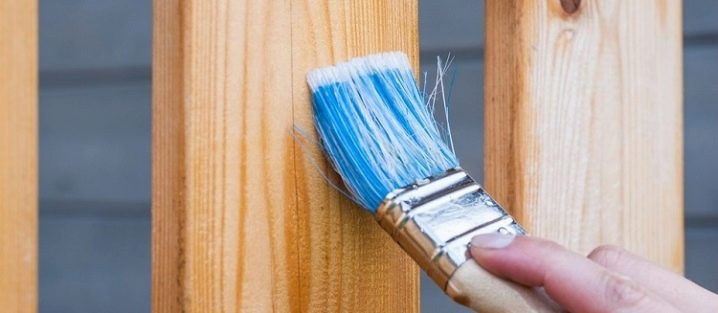
Water-soluble mixtures are not the most functional type of wood stains.
- They have a long drying time (fifteen hours).
- After processing and drying, pile may rise on the surface of the material. In this case, the wood must be sanded.
- Water stain applied in large quantities to the product, after drying, can provoke the appearance of cracks on the surface.
Modern manufacturers of building materials also produce universal tinting mixtures, which can be classified as a type of water stain. Water, alcohol, or acetone can be used as a diluent for universal formulations. The advantage of making an alcohol or acetone solution from a universal mixture is that it will dry faster.


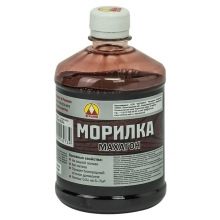
What is the difference and which is better?
In the modern building materials market, there are many types of wood stains, each of which has its own advantages and disadvantages. Varieties of tinting solutions primarily differ in composition.
Non-aqueous mixtures are made from polymers, coloring components and organic solvents. This solution forms a waterproof film on the surface. Unlike a water-based mixture, this type does not provoke swelling of the wood structure. It is not necessary to varnish the surface after applying a non-aqueous stain.


A non-aqueous solution has its own disadvantages:
- Strong unpleasant odor. Despite the fact that it quickly disappears, the room must be well ventilated during work.
- If dust gets on the solution or a wet treated surface, it will be quite problematic to remove it.
- Defects that may appear on the surface due to inaccurate application of the solution (drips, stains) are difficult to remove.
- The mixture dries for a long time. Drying time is on average twelve hours.


Alcoholic mixtures are a solution of dyes and alcohol. During finishing work, the coloring components penetrate into the structure of the tree, and the alcohol evaporates. This solution has a high drying speed, which ranges from fifteen to thirty minutes. It is necessary to apply such a composition quickly to avoid uneven coverage and the appearance of spots.
Alcohol based stain is moisture and UV resistant. The disadvantages of this solution include a bad smell.
Nitro-stains are made on the basis of solvents. They dry quickly and also require quick application to the material.


Oil mixtures are most often made on the basis of flax seed oil. This formulation forms a sun-resistant coating. The surface will not fade for a long time and will have a pristine appearance.
The oil-based stain adheres easily and evenly to the surface without lifting the wood grain. Drying time of the solution can be from two to four hours.
Acrylic compounds are environmentally friendly and odorless. In addition, such mixtures are fireproof. Acrylic stain adheres well to all tree species and dries quickly. Acrylic solutions are most often used for treating wooden floors. Special care should be taken when applying multiple coats, as stains are likely to occur.


Previously painted surfaces can be treated with wax solutions. After drying, this mixture forms a protective waterproof layer on the product. The wax coating gives the wood its brightness, but does not penetrate into the structure of the material. It should be remembered that the surface should not be treated with a wax solution before applying the two-component varnish.
Whitening stains are made from acids. Such a solution is capable of making the surface several shades lighter. This composition is intended for the preparation of wood before further processing with paints and varnishes.
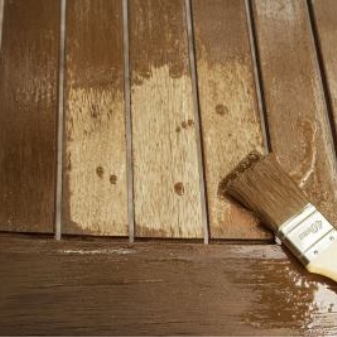

Water mixtures may be inferior in certain characteristics to other types of wood stains. However, water-soluble formulations are low cost and harmless to health. Such a solution is perfect for interior work, as it does not have an unpleasant odor.
Each type of wood stain has its own advantages and disadvantages. Knowing the basic characteristics of the mixtures, you can easily choose the right solution for carrying out any specific work.

Colors
Since water stains are designed to emphasize the texture of the wood, and not hide it, manufacturers produce mixtures in a color scheme that matches the existing natural shades of wood species. A non-standard palette of shades (non-woody bright colors, as well as white and black tones) is inherent only in acrylic, wax and oil solutions that are used to paint the surface.
Water-based blends are available in a wide range of colors, from light shades to deep dark shades.The closest shade to black is ebony. It should be borne in mind that different manufacturers may have different names for the same shade.
Water-based colored stains usually have the following shades:
- citric;
- larch;
- maple;
- oak;

- mocha;
- rosewood;
- walnut;
- mahogany;
- Red tree;
- burgundy;
- plum;
- ebony.
When choosing a particular shade, it is worth remembering that the color sample on the tester may differ from the final result that you get after processing the wood. On different tree species, the solution can give a wide variety of shades. For this reason, it is necessary to apply a small amount of the mixture to a small hidden area before staining the product.

Application rules
The final result of wood staining is influenced not only by the quality of the solution, but also by the correctness of its application.
There are a number of rules that must be followed when staining with aqueous compounds:
- the solution is applied to the surface along the fibers;
- large areas can be covered with the mixture by spraying;
- on small areas, the liquid is applied using soft paint brushes or a foam sponge;
- to prepare a solution from dry aqueous mixtures, the powder must be diluted only in soft or purified water;

- before treating wood with a tinting solution, the surface must be well cleaned of dirt, grease and resins;
- before processing wood with an aqueous composition, it is recommended to moisten the surface with water to avoid the formation of lint;
- if the solution is slightly warmed up before starting work, the stain will penetrate better into the structure of the material.
Water-based formulations can be combined with other types of wood stains or with primers and varnishes. As a result, interesting effects and shades can be achieved.

Manufacturers
Water-based stains may vary in quality and some properties. When buying a solution, it is recommended to opt for a well-proven product. Previously, you can familiarize yourself with the popular manufacturer of water-based wood stains.
Company "Novbytkhim" produces a line of water stains in a wide range of colors. These products can be used not only for interior, but also for exterior decoration, provided that after staining, the surface will be varnished. The product has predominantly positive customer reviews. Consumers note the good quality, ease of application, low cost and harmlessness of the solution.


Water stain "Latek" improves the wear resistance of the processed material, which increases the service life of the product. After drying, this solution forms a vapor-permeable film, so that the coating does not fade under the influence of sunlight. Consumers of this product are quite satisfied with its quality, but warn that the color on the tester may differ significantly from the shade on the surface after staining.
Water based stain Trae lyx designed to change the shade of soft and hard wood. Solutions of different shades can be mixed with each other to obtain the desired color. Trae Lyx can only be used for interior use. The stain is available in a wide range of colors, as well as in a transparent version.


In the next video, you will find a useful video tutorial on the use of wood stain.











The comment was sent successfully.